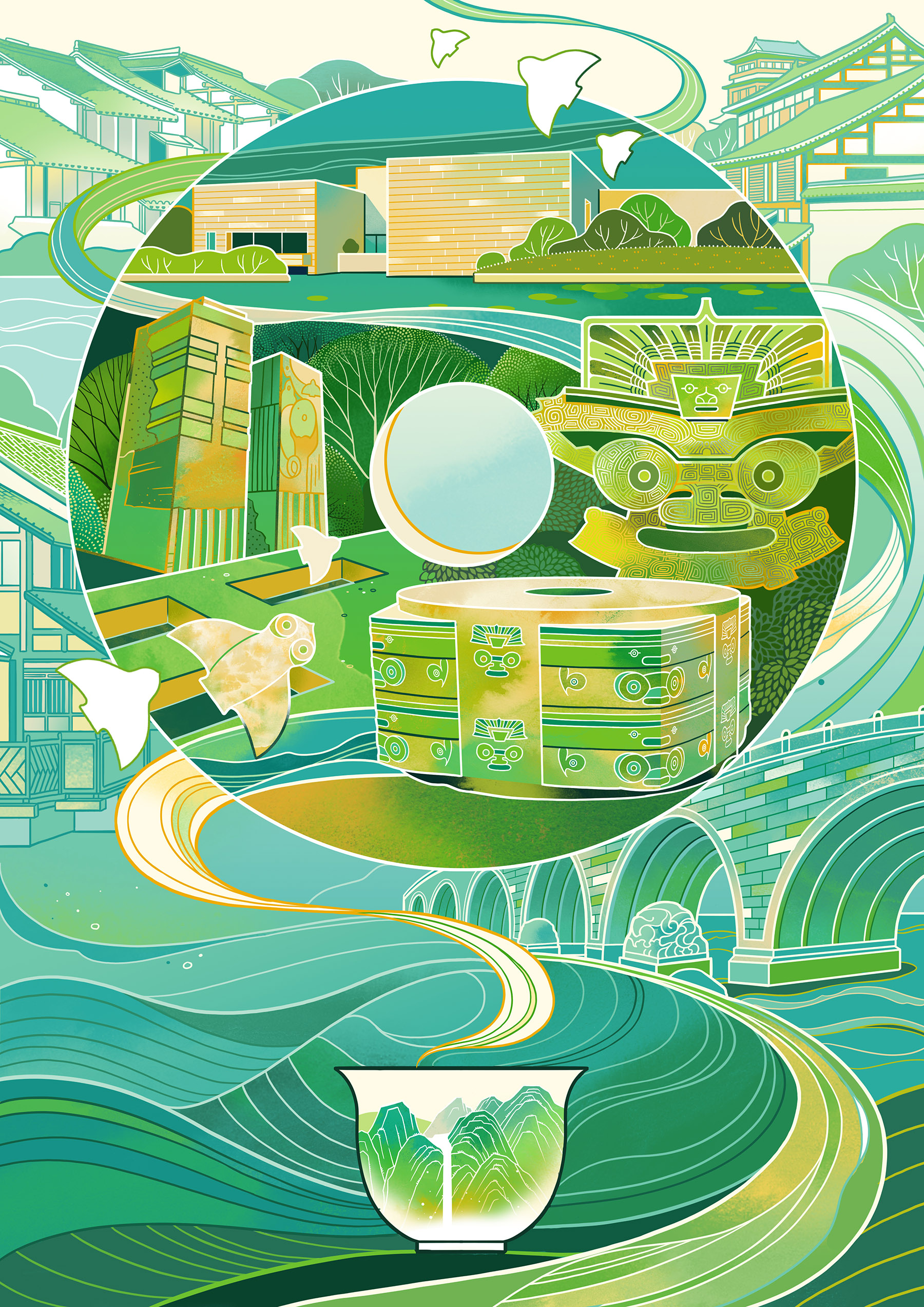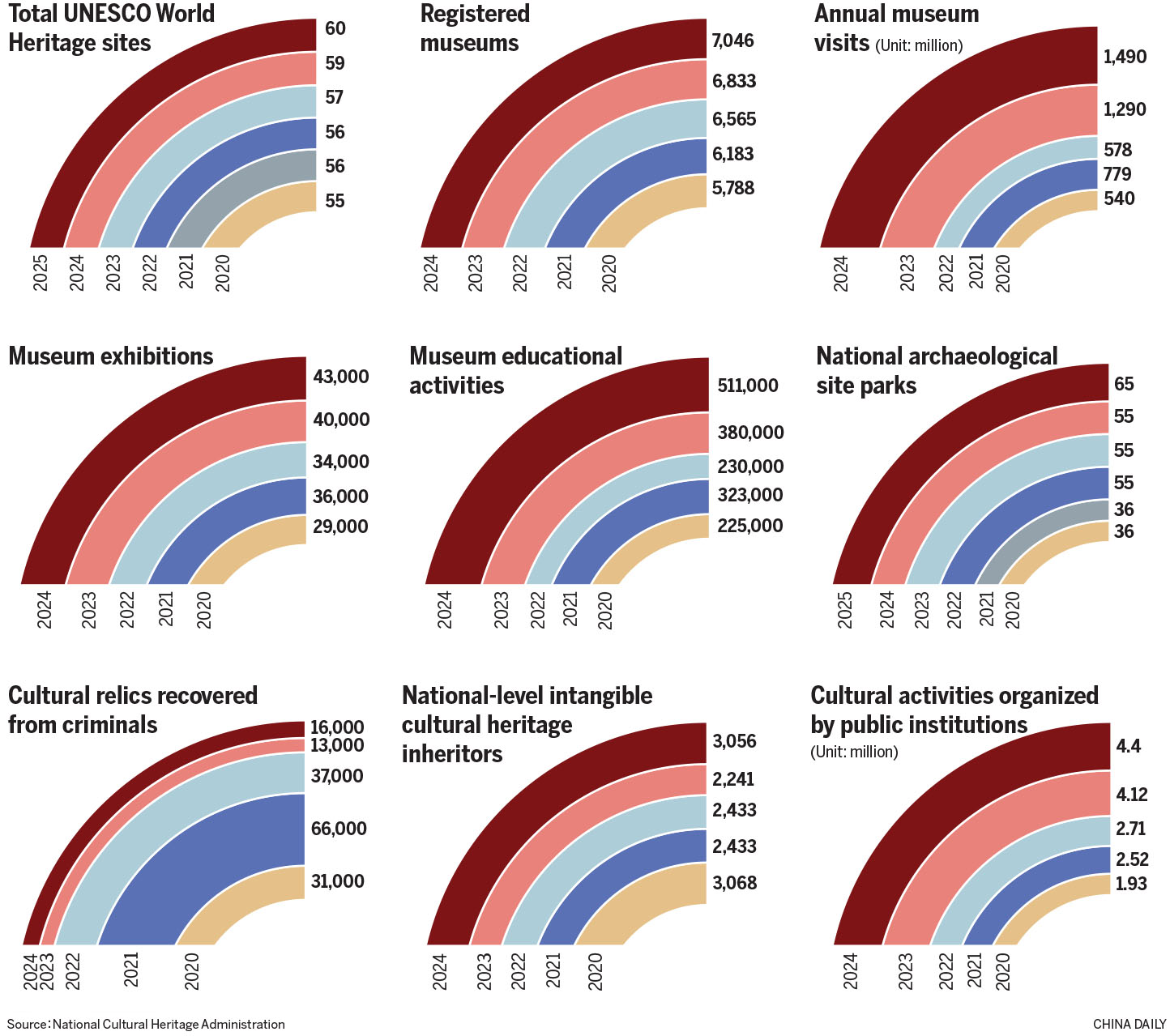Relics, exhibitions, new technologies add heft to country's cultural standing

The world record attendance to see Shanghai Museum's On Top of the Pyramid: The Civilization of Ancient Egypt exhibition came as no surprise to observers of China's growing fascination with museum visits.
After concluding a successful 13-month run, the museum announced on Aug 18 the event was the best attended single paid exhibition among museums globally, with over 2.77 million visits and more than 760 million yuan ($106.75 million) in revenue generated.
While the 14th Five-Year Plan (2021-25) urged a more robust museum system in China, major achievements in archaeological studies have infused museums with fresh vitality, helping them present dazzling new exhibitions to the public.
READ MORE: Museums celebrated around the country
China had 7,046 registered museums as of the end of 2024, according to the National Cultural Heritage Administration, recorded nearly 1.5 billion visits in total, and held about 43,000 exhibitions last year.
"During the 14th Five-Year Plan period, the public's demand for museums has become increasingly evident," said Pan Shouyong, a museology professor at Shanghai University. "Visiting museums to explore new exhibitions and 'check in' has become a common phenomenon."
He added that behind the visible surge in numbers of museums, exhibitions and visits is strong support from both the government and broader society.
Upgraded efforts
Over the past five years — to better promote the development of museums — China has stepped up efforts to construct museum echelons by consolidating the museum grading system, according to Pan.
This system regulates three tiers of museums nationwide based on their performance in management and infrastructure; their collection management and scientific research; and their exhibition and social services. All these factors provide direction for further improvements.
Museums including the National Museum of China and the Palace Museum in Beijing and 15 key museums are supported by both the central and local governments. They are strong contenders for becoming world-class museums.
The remaining museums will implement a classification system. Last year, the latest grouping of China's first-, second- and third-tier museums was announced, bringing the total number of such museums in China to 1,660 and meeting different needs of visitors.
A guideline to promote the reform and development of China's museums, which was issued by nine departments in 2021, encouraged the formation of a museum development framework that is well-planned, structurally optimized, distinctive, institutionally sound, and fully functional by 2025.
"At that time, we thought the goal was a bit too ambitious," Pan said. "But looking back, we find the goal has been achieved as a complete museum system has begun forming," he said, adding that work to boost China's museum strength is continuing.
Cities such as Beijing, Taiyuan, Shanxi province and Nanjing, Jiangsu province, have integrated their rich museum resources into city development and each tried to build themselves into "a city of museums", hoping to give full play to the strength of museums to meet people's aspirations for improved lifestyles, said Pan.

Key players
China's museum professionals are also playing increasingly important roles on the international stage in decision-making and contributions to the industry.
"If we say that during the 13th Five-Year Plan (2016-20) China's museums began to be known by the global profession, then in the past five years, we have shown our abilities and strength on the global stage," said Pan.
For example, An Laishun, a professor at Shanghai University, who once worked as vice-president of the International Council of Museums, voted with his peers for the new definition of museum, which was released by the ICOM in 2022.
Zhao Feng, honorary director of China National Silk Museum, is currently a member of the executive board of the ICOM.
More Chinese experts are working in ICOM Regional Alliance of Asia-Pacific countries and other cross-regional projects related to museums and heritage.
"With China's museum professionals gaining international influence … Chinese professionals' voices and opinions are becoming indispensable in making key decisions on big events," said Pan.
"The number of Chinese people learning and working in top overseas universities and institutes cultivating museum professionals has surged in recent years as well."
The achievements of museums are inseparable from the booming archaeology work in China.
Rao Quan, head of the National Cultural Heritage Administration, said at a meeting held in Chengdu, Sichuan province in September that during the 14th Five-Year Plan period, under the high attention of China's top leadership, with strong support from governments at different levels and through the concerted efforts of all cultural relics and archaeological professionals, significant new achievements have been made in archaeological work.
Archaeological progress
Archaeological work is transitioning from the ivory towers of in-depth academic research to becoming a solid support for the national cultural strategy, according to Rao.
In the past five years, for instance, the fifth phase of a major research project to trace the origins of Chinese civilization has been completed, exploring the regional characteristics of the areas where Chinese civilization began and the underlying components.
Progress has also been made on 21 major subjects included in the "Archaeology China" program, which tries to study early Chinese history through well-planned excavations. A total of 1,284 active archaeological projects are well advanced, shedding fresh light on key research areas.
For example, the discovery of a million-year-old human skull in Shiyan, Hubei province, on May 18, 2022, provides key information in the origins of human beings.
The so-called No 3 skull of Yunxian county man was discovered 33 years after No 1 skull was found. With a complete structure, the skull presents features of Homo erectus and provides more information on human beings from the period.
Other discoveries provide key evidence on the origins of agriculture, China's development as a unified country with multiple ethnic groups, and the cultural inheritance of the Xia (c.21st century-16th century BC), Shang (c.16th century-11th century BC) and Zhou (c.11th century-256 BC) dynasties, Rao said.
The deep integration of archaeology with natural scientific methods has been a feature of China's archaeological studies in recent years, said Jia Xiaobing, a researcher at the Chinese Academy of Social Sciences' Institute of Archaeology.
DNA analysis of ancient materials, molecular biology and isotopic analysis have been applied in complicated subjects like the migration of ancient people and their subsistence patterns, helping unveil the evolution of civilization.
"The technological means are no longer auxiliary tools, but an indispensable part of explaining archaeological discoveries," said Jia.
Archaeology is also cooperating with other social sciences like history, philology, philosophy, sociology, anthropology and religious studies to advance understanding.
ALSO READ: Cultural and Heritage Day sheds light on Chinese civilization
In addition to exploration work in their homeland, Chinese archaeologists are making contributions to archaeological studies overseas.
Over the past five years, Chinese scholars have carried out six cultural relics restoration projects in four countries and taken part in 49 joint archaeological projects in 28 overseas countries and regions with their foreign counterparts.
"Ancient China always maintained intricate connections with the outside world, with the Silk Road, for example, serving as a channel for these interactions since ancient times," said Wang Wei, a senior archaeologist at the Chinese Academy of Social Sciences. "Without understanding foreign historical and archaeological materials, it is difficult to conduct in-depth research on the development of ancient Chinese history and culture," he said.
"Chinese archaeological scholars are showcasing our abilities on the global stage. With our strength and advanced technological methods, we have become a significant power worldwide in this field," he added.
Contact the writers at wangru1@chinadaily.com.cn


